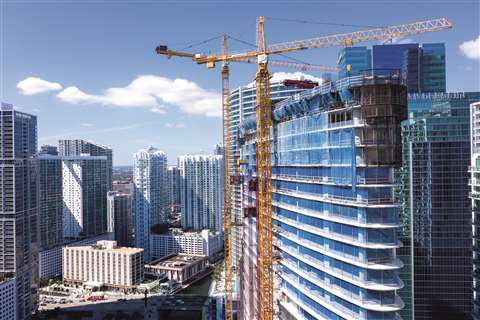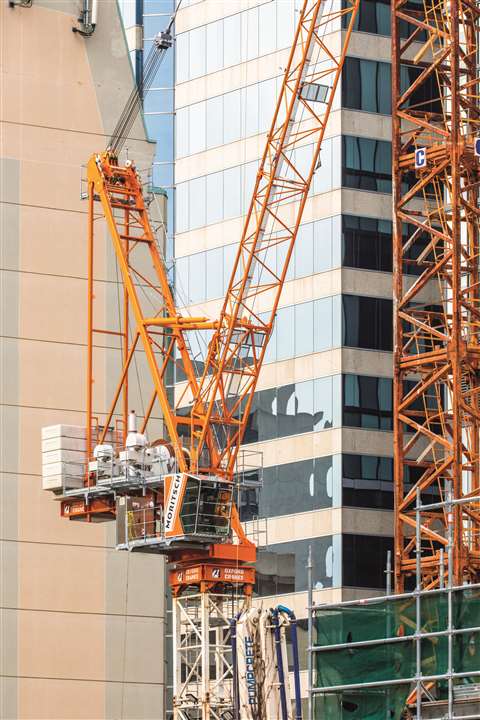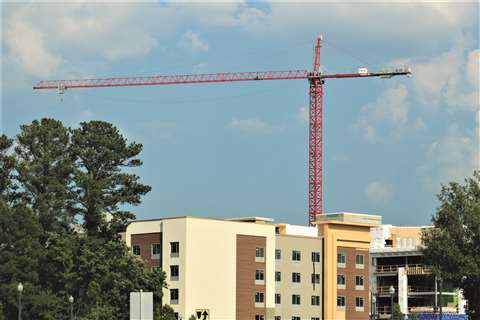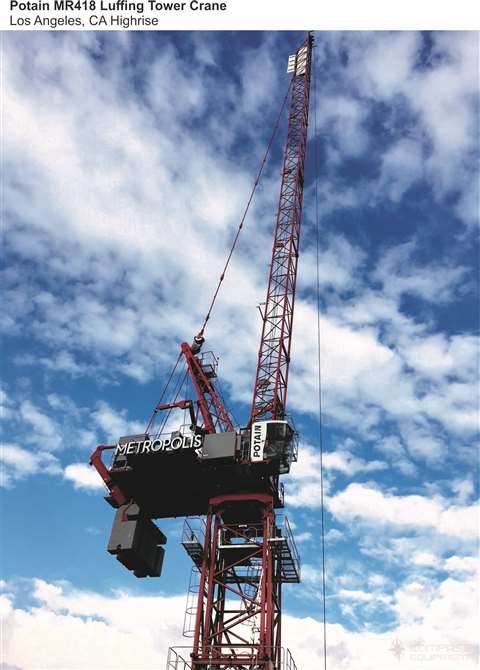North American tower crane sector remains active
15 November 2021
Despite economic and pandemic challenges, D.Ann Shiffler reports the tower crane market is holding up.
More people work remotely than ever before. Urban high rise buildings that used to overflow with office workers are largely vacant, with employees opting to work at home or chose a hybrid work schedule that allows them home and office days. Has the pandemic stopped or delayed the construction of commercial real estate space?
 Two of Morrow Equipment’s Liebherr 420 EC-H 16 units work on the Aston Martin Luxury Residences in Miami, FL
Two of Morrow Equipment’s Liebherr 420 EC-H 16 units work on the Aston Martin Luxury Residences in Miami, FL
According to most news reports and commercial real estate research, the commercial real estate sector is in a state of flux, but that hasn’t stopped high rise residential, hotels and medical construction. As well, the industrial real estate market is very strong with new development occurring throughout North America.
Morrow Equipment, based in Salem, OR, is the largest tower crane-owning company in the nation, and it rents tower cranes from coast to coast. President and COO Peter Juhren is constantly assessing the various urban markets, and he described the market as active, and up and down.
“It’s active but it’s a roller coaster,” he said. “Many tower crane companies are competing for the same projects, and this is to the benefit of the contractors.”
Other challenges must be considered too, Juhren said.
“Depressed rates are a big factor, as many tower crane companies are focused on utilization over rates,” he said. “This is driving down revenue for all.”
 Oxford Builders’ tower cranes are working at Union Station in Toronto.
Oxford Builders’ tower cranes are working at Union Station in Toronto.
Soaring freight costs
Logistics is also a big problem, given the status of current supply chain issues around the globe. Juhren said trans-ocean freight costs are soaring and shipments are often delayed or halted.
“As of this writing there are 73 ships anchored off the Port of Long Beach, with estimated wait times to unload of 18 to 21 days,” he said. “If owners did not plan accordingly, the availability of new cranes and spare parts will be a big problem.”
But again, there’s a lot to be optimistic about, Juhren said.
“Utilization is climbing, and I see a much better growth picture in the second to third quarters of 2022,” he said. “There is plenty of idle capital sitting around, and the commercial sector has roared back. Demand for housing is still hot, as is the condo market regionally. I also see an uptick in infrastructure jobs such as water treatment plants and natural gas storage.”
For Morrow, the large capacity luffing boom cranes are in the highest demand, as well as cranes above 500MT.
“Self-erect cranes are also starting to become more popular, and Morrow has had good success in the past year in this market,” he said.
As far as the most popular model in the Morrow fleet, Juhren said, as is the case with most tower crane companies, the 400 MT range is the sweet spot in the United States.
“Our Liebherr 420 EC-H is the most popular and highly utilized crane in our fleet,” he said. “Larger cranes are gaining ground, but the 400MT size has been the bread and butter in the U.S. for over 40 years.”
Mike Demelo, vice president and equipment manager for Oxford Builders, based in London, Ontario, said in his market in Canada, the biggest challenges are skilled workers, including crane operators and technicians, mainly because there are no training facilities or schools that service this sector.
“Our utilization is excellent at the moment,” he said. “All different capacities and models are in high demand.”
In the urban areas in Canada, high rise residential is driving the market.
As for the most sought after tower cranes, Demelo said in hammerheads it’s the 300 to 400MT units and for luffers, it’s the 200 MT ranges. The SK415 and CTL260 are the most popular cranes in the Oxford fleet.
Downward pressures
Robert Kohler, vice president of Crane Tech Solutions, based in Portsmouth, VA, and the exclusive distributor for Jaso tower cranes, said the market is steady, but agreed there are downward pressures on rental rates in several markets that had been growing.
 A JASO J145 works at an apartment complex in Virginia Beach.
A JASO J145 works at an apartment complex in Virginia Beach.
“The biggest challenges are maintaining utilization and negotiating acceptable terms and conditions,” he said.
As well, he thinks that as the pandemic subsides and more people return to work, things will get better.
“Companies [need to] limit work-at-home options and focus more on employees coming into the office,” Kohler said. “Business travel must return to previous levels. This may increase the need for tower cranes and increase utilization.”
Commercial real estate projects are still in progress and cranes are needed to build them, Kohler said.
He agreed that in his company’s markets, the 300 and 400 MT cranes are still the primary size cranes in demand.
“We have not seen many requirements for the larger cranes,” he said. The most popular model crane in the CTS fleet is the JASO J300.
Compass Equipment’s Sales and Marketing Director Paul Autry contends that better times are ahead. Based in Phoenix, AZ, Compass’s market includes Arizona, California, Colorado, Nevada and Texas.
“The tower crane market in 2021 is gaining momentum with a strong showing to come in 2022,” he said. “There are some very focused infrastructure action plans that are aimed at increasing new construction and refurbishment projects. The diverse demand for manufacturing, multi-residential, telecommunications as well as oil and gas are driving factors in the tower crane market growth. It seems that many of the projects that were on hold or taken over by new GCs/investors are now moving forward setting the stage for a very strong 2022.”
Autry echoed Demelo that finding talented operators and technicians is more challenging than ever.
“We are now using a variety of strategies to find new hires for our specialized positions,” he said. “As a dealer, we have access to certified manufacturer training programs as well as our internal NCCCO Certification Training Center, so finding the right individuals to invest in and put through these programs is more of a challenge today. We work with veteran’s groups, network with trade schools and conduct equipment ‘show and tell’ demos for interested individuals looking for a career in construction.”
 Compass Equipment’s Potain MR418 works at the Metropolis residential high rise project in Los Angeles.
Compass Equipment’s Potain MR418 works at the Metropolis residential high rise project in Los Angeles.
Utilization will also improve when the market better understands how a self-erecting tower crane or tower crane offers a more efficient strategy in overall building return on investment.
“More and more jobsites are getting tighter and are restrictive in terms of area available for equipment, offering a perfect scenario for a tower crane,” he said. “There are still many contractors that are comfortable with forklifts, telehandlers and mobile crane strategies whereas in efficiency, safety and overall logistics a tower crane or self-erector is a much better solution with better return on investment.”
Driving factors
Autry contends that there isn’t one dominant sector – commercial real estate, stadium projects, government buildings, medical, hospitality – driving growth in the tower crane market.
“All of these segments are driving factors to the current market, including multi-unit residential and large entertainment district projects,” he said. “Manufacturing is big as well, which in turn drives the need for residential builds. Another segment is in the refurbishment projects. Again, typically tight jobsites offer a perfect fit and strategy for a tower crane.”
For Compass, there are two crane models that are seeing the most demand.
“Our large 45 meter self-erecting tower cranes and our medium city tower cranes are consistently at a high utilization rate,” he said. “Our Potain T85A self-erecting tower cranes and our Potain MCT88, MDT98, MDT178, MDT219 models are in very high demand. Our large hammer head tower cranes and flat tops (like our MDT389s) are filling up quickly for the first and second quarters of 2022.”
Autry said the Compass team is excited about the market and what’s to come.
“At this very moment, our MA21s (the smallest self-erectors in our fleet) are our least in demand,” he said. “But we have hired a new representative to focus on the three to six-story projects only, so that should change.”
Autry said the most popular model in the Compass fleet is a toss up between the 45 meter self-erecting tower cranes and small to medium size flat top tower cranes.
STAY CONNECTED


Receive the information you need when you need it through our world-leading magazines, newsletters and daily briefings.




